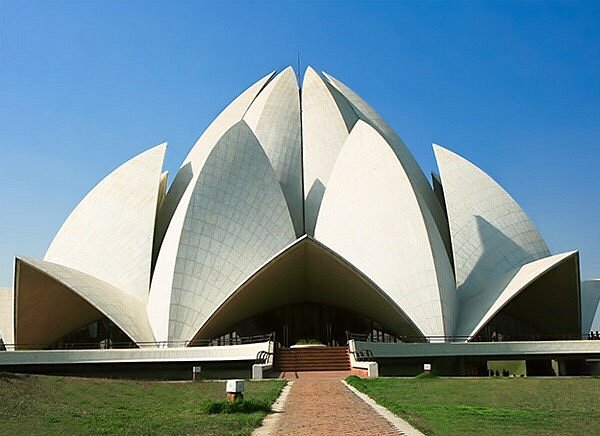“If you are a travel enthusiast, you must have travelled to the most alluring places in the world, or if not, you were willing to do so in order to fulfil this dream. Today, in this blog, I am acquainting you with the most attractive and sophisticated monument of Delhi. Yes, you guessed it right; it is none other than Lotus Temple.
The Lotus Temple, also known as the Baha’i Temple of Worship located in New Delhi, stands out for its distinctive architectural design resembling a lotus flower, symbolizing the inclusivity of the Baha’i faith. Constructed in 1986 by Iranian architect Fariborz Sahba, the temple’s marble petals form concentric rings housing nine entrances, an outer hall, and an inner sanctuary accommodating up to 2500 individuals. Inspired by the significance of the number nine in Baha’i, Hindu, and Buddhist traditions, the temple encourages people of all beliefs to engage in meditation and prayer.
In contrast to traditional Indian architecture featuring elaborate engravings and sculptures, the Lotus Temple boasts a minimalist design focused on maximizing natural light and water elements. Sahba prioritised sustainability by incorporating outer ponds for cooling and implementing solar energy systems. Recognized with numerous architecture awards and featured in renowned publications, the Lotus Temple stands as a testament to innovative design and spiritual inclusivity.
Location

The Lotus Temple is situated in the heart of New Delhi, the capital city of India. Specifically, it is located in the southern part of the city, near the neighbourhood of Kalkaji. The address of the temple is Bahapur, Shambhu Dayal Bagh, Kalkaji, New Delhi, Delhi 110019, India
History
The Lotus Temple in Delhi, a Bahai House of Worship, also referred to as Mashriqu’l-Adhkár, was unveiled to the public in December 1986. Aligned with the Bahai principles of unity among religions and mankind, it embraces followers of all faiths, offering a space for prayer, worship, and scriptural study. Regarded as one of the seven prominent Bahai Houses of Worship worldwide, it stands as the sole representation in Asia
Architecture
The Lotus Temple in Delhi, a Bahai House of Worship, also referred to as Mashriqu’l-Adhkár, was unveiled to the public in December 1986. Aligned with the Bahai principles of unity among religions and mankind, it embraces followers of all faiths, offering a space for prayer, worship, and scriptural study. Regarded as one of the seven prominent Bahai Houses of Worship worldwide, it stands as the sole representation in Asia..
Some special facts about lotus temple
Attracting approximately 4.5 million visitors annually, the temple ranks among the world’s most visited landmarks.
In India, the temple is honored with its depiction on a ₹6.50 postage stamp.
Fariborz Sahba’s selection of the lotus symbol stems from its widespread significance in Hinduism, Jainism, Buddhism, and Islam.
Distinguished as the inaugural temple in the national capital to integrate solar energy.
Ardishír Rustampúr, a devout Bahai from Hyderabad, Sindh province, Pakistan, generously contributed his life savings to procure the temple’s land.…
How to reach?
Lotus Temple is easily accessible as there are multiple options that connect the temple to the city. Some of them are:
By Road: There are 8-10 bus routes by DTC that pass near the Lotus Temple. There are options for cabs and autorickshaws as well.
By Metro: Lotus Temple’s nearest metro station is Kalkaji with a distance of 500m from the temple.
By Train: New Delhi Railway Station is the nearest to the temple.
By Air: Indira Gandhi International Airport is the nearest airport to the temple.
Places to Stay nearby: Hotels near Lotus Temple
Significance
In Hindu, Buddhist, and Baha’i traditions, the lotus is a symbol of unity, clarity, and harmony, which align with the Baha’i tradition of welcoming many faiths into its temples and religious spaces. The Lotus Temple welcomes practitioners of all religious faiths to use and visit its spaces. As such, each temple offers no organised ceremonies or practices. Nor do their worship spaces hold clergy or endorse any one faith. Instead, Baha’i temples traditionally involve open spaces for individual contemplation, scripture study, and prayer. Chanting and choral performances are allowed and encouraged within the temple, but musical instruments are prohibited.
Final thoughts
The mesmerising beauty of the Lotus Temple will leave you amazed. The marvellously engraved structure is something that is worth lauding. Hence, if you want to see something that will entangle your mind with splendid beauty, then this is the place.”.











